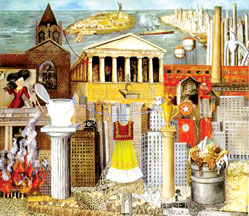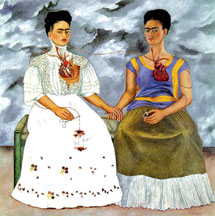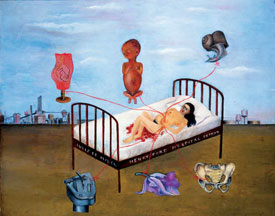The art of Frida Kahlo

In last week's column, I reviewed the life and work of Frida Kahlo,
wife of famous Mexican muralist, Diego Rivera. Frida Kahlo eventually
became a celebrated painter in her own right, although she only reached
cult status after her death. In the previous article, I gave a
chronological account of Frida's life and work and mentioned the two
biographical films that document her life. In this column, I review some
of Frida's most famous paintings, to give the reader a deeper insight
into her mindset. Frida's work is very significant in terms of
understanding some of Mexico's modern cultural landscape, since she has
become synonymous with the notion of 'La Mexicana', (the Mexican woman).
The Bus - 1929
 |
|
My dress hangs there
1933 |
|
 |
|
The Two Fridas 1939 |
 |
|
My Nurse and I - 1937
|
In this colourful painting, influences from Diego Rivera's style is
clear. Frida depicts the different classes within Mexican society and
their daily lives. Sitting side by side in this painting are a housewife
with her market basket, a blue collar worker in overalls, an indigenous,
barefoot mother breastfeeding her baby, a small boy, a well dressed
capitalist 'Gringo' holding his bag of money and a young girl (possibly
Frida herself).
Some elements in the painting may refer to the near fatal accident in
which Frida was badly injured. For example, a man in blue overalls
removed the handrail that pierced her body during the accident and a bag
of gold dust spilled over Frida's injured, bloody body after the
accident.
Henry Ford Hospital (The Flying Bed) 1932
In July 1932, Frida suffered a miscarriage in Detroit. In this
disturbing painting, Kahlo shows herself lying on a bed in the Henry
Ford Hospital after a miscarriage. The figure is unclothed, the sheet
underneath is bloody and a tear falls from her left eye. The main
subject (the bed with Frida lying on it) are surrounded by six floating
images, all relating to the miscarriage. All of them are attached to red
strings which she holds to her stomach, as though they were unbilical
cords.
The main image is a perfectly formed male foetus (the mini Diego that
she had longed for), the orchid was a gift from Diego and the snail
alludes to the slow pace of the miscarriage. The pink female torso was
Frida's idea of "showing the insides of a woman" and the cruel looking
machine shows the "mechanical part of the whole business" she said.
Finally she included the fractured pelvis in the lower right corner is
there because it explains why she was unable to have children. This is
undoubtedly one of the most painful pieces of work that Frida Kahlo
produced.
Self portrait on the borderline between Mexico and the United States
1932
After being in the United States for nearly three years, Frida was
growing homesick for Mexico. In this painting, she shows her ambivalence
towards 'Gringolandia' (the United States). The painting shows her
standing on the border line between the two countries. In an
uncharacteristically sweet, pink dress, Frida stands like a statue on a
pedestal between two completely different worlds.This painting is
composed symmetrically with the space broken into foreground, middle
ground, and background. In the foreground, all objects are placed neatly
in a row and establish a border that guard the middle ground.
In Frida's left hand she holds a Mexican flag made of papel picado
('cut paper', a traditional Mexican art form) that crosses over to the
Mexican side. This indicates where her heart and her true loyalties lie.
In her right hand she holds a cigarette and this side of the image is
dominated by what Kahlo sees as a representation of industry and the US.
The right half has in its foreground a red blaring speaker, a dark flood
light, a machine, a concrete block, and cables from all these mechanisms
inside the earth. The middle ground is dominated by grey pipes and
shafts, against a dirty beige background, which is engulfed by a horizon
full of skyscrapers. Columns of smoke spew fumes within which the
American flag flies. The name "Ford" is written across the
industrialized chimneys. On the right side, she has painted the
technologically dominated landscape of the United States in dull greys
and blues.
The left half of the painting illustrates a Mesoamerican/Mexican
landscape, with its warm, natural earthy colours, exotic plants and
pieces of Aztec sculpture. The plant roots penetrate the earth to form a
weblike pattern and the natural life cycle governs the Mexican side. The
middle ground is dark brown and has two fertility figures (one light and
one dark), along with rubble and a stone skeleton's head. A mountainous
Mexican pyramid dominates the horizon. The sky has two cloud formations:
one containing a fire spewing sun and the other embedded with the moon.
The meeting of these two formations yield a red lightning bolt, showing
the clash between two cultures. There is just one link between the two
worlds - an electricity generator standing on U.S soil, which draws its
power from the roots of a plant on the left (Mexican) side. This is
significant because it is often said in Mexico that the U.S plundered
Mexico of its natural resources, turned the materials into medicines and
other marketable products and made enormous profits as a result.
My Dress Hangs There 1933
 |
|
The Bus 1929 |
Following the miscarriage in 1932 and having lived three years in the
United States, Frida's ambivalence became a desperate longing to return
to her native Mexico. However, Diego, fascinated by the States and
delighted by his popularity there, chose to stay there longer than Frida
would have liked. It was out of that conflict that this painting came -
Kahlo's one and only collage. It is an ironic representation of American
capitalism and superficiality. Filled with symbols of a modern American
industrial society, it points to social decay and the destruction of
fundamental human values.
In this painting, Frida takes an opposite view to her husband, who
expressed his approval of industrial progress in a mural at the
Rockfeller Centre. The component that is missing from this painting is
the focal point of most of her other paintings - herself. Instead her
Tuhuana dress hangs empty admidst the choas in the background; possibly
Frida's way of saying "I may be in America but only my dress hangs there
- my life is in Mexico"
My Nurse and I 1937
 |
| Henry Ford Hospital
(The Flying Bed) |
 |
| Self portrait on
border between Mexico & the USA |
Frida's mother was never able to breastfeed her, so the family
employed a Native American wet-nurse for the sole purpose of
breastfeeding Frida. The relationship between the wet nurse and the
infant appears cold and distant, reduced to a practical, biological
function. As it was the adult Frida who had the memory, she has painted
a fully grown head on herself as an infant. As she could not remember
her wet nurse's facial features, she painted a pre- Columbian mask in
its place. The wet nurse does not cuddle Frida but holds her as though
presenting a sacrifice. In this image, Frida has subverted the 'Madonna
and Child' mothering image into an expression of loss and separation
from her own mother, with whom she never really bonded.
The Two Fridas 1939
Shortly after her divorce from Diego, Frida completed this self
portrait of two very different personalities. On the right is the person
that was loved and respected by Diego, the Mexican Frida in Tuhuana
costume. In her hand she holds an amulet bearing the portrait of Diego
as a child. On the left is a rather more European Frida in a lacy,
white, Victorian wedding dress - the Frida that Diego abandoned. The
hearts of the two versions of Frida lie exposed - a device Frida often
used to express her pain.
The unloved Frida's heart is broken, while the loved Frida's heart is
whole. From the amulet that this Frida clutches, springs a vein that
runs through both women's hearts and is finally cut off by the surgical
pincers in the hand of the rejected Frida. In despair, this Frida tries
to stop the flow of blood from Diego but it keeps dripping and she is in
danger of bleeding to death. The stormy sky, filled with agitated clouds
may reflect Kahlo's inner turmoil. Holding her own hand, she is her only
companion.
Frida Kahlo produced numerous other paintings and this is by no means
an exhaustive list. However, it is beyond the scope of this article to
explore all of those paintings. Additionally some of her work is rather
gruesome and I am reluctant to impose too many of the more graphic,
disturbing paintings on the public. Subsequent columns will review the
life and work of Frida's husband, Diego Rivera, and a fictional
epistolary from Angelina Beloff, to Diego, who was her former lover.
This should help to further contextualise Frida's life experiences,
her inner world and the paintings which she produced in response to
these.
The writer has a Masters Degree in Hispanic
and European Studies from Aberdeen University, Scotland. She also writes
for The Guardian (UK). |

